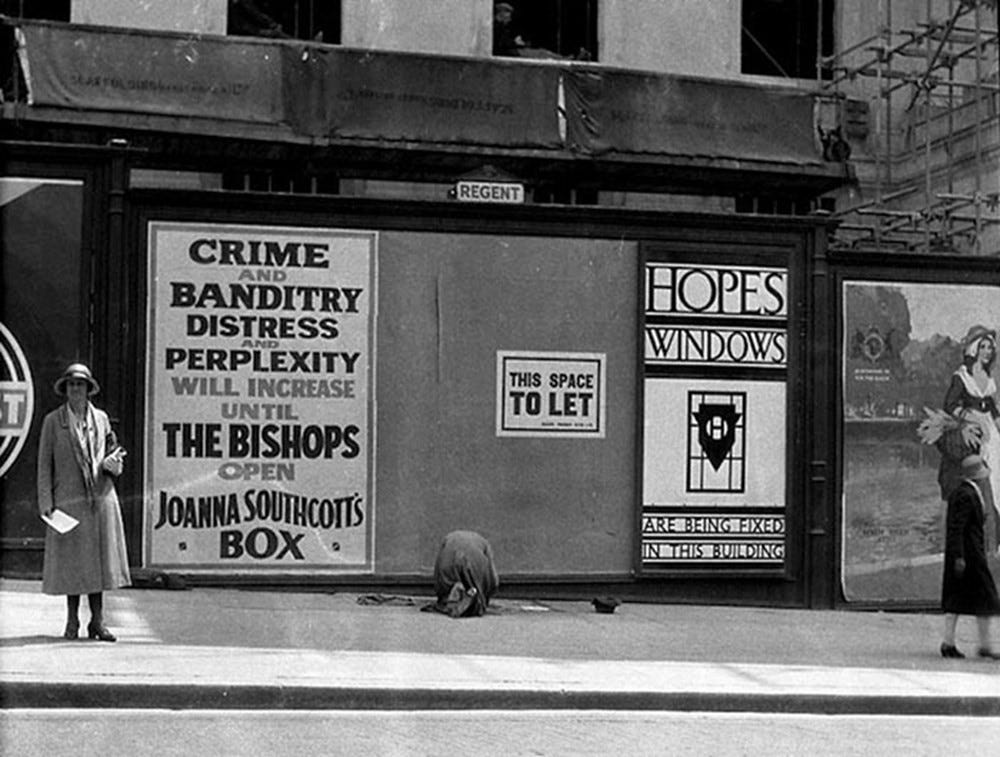The Box of Sealed Writings of Joanna Southcott, prophetess
There was something very mysterious about him, but nothing uncomfortably mysterious
Note: This is the final part of a three-issue series.
An audience of 400 gathered in Westminster’s Church Hall. It was a momentous occasion – historic, even. Anticipation hit a fever pitch for all present, save for Harry Price, the psychic researcher who organized the whole affair. He was well-acquainted with the contents of Joanna Southcott’s box, having x-rayed it in the lead up to the July 11th event. Price, however, was excited for different reasons, looking forward to the audience’s reaction.
Seven members of Mabel “Octavia” Barltrop’s Panacea Society gathered outside, handing out pamphlets in the pouring rain. It wasn’t a protest of the opening, exactly. The group, formed a little over 100 years after Southcott’s death, rejected Price’s pronouncement. If his was, indeed, a Southcott box, it wasn’t the Southcott box, which they’d claimed to have securely hidden in a bedroom more than 200 miles away.
Their handouts bore a picture of the “true” box, noting, “The Box of Sealed Writings of Joanna Southcott, prophetess, which the 24 bishops will open, remains and will remain in safe custody until circumstances force the bishops to do what they refuse to do.”
Price had failed to meet Southcott’s demands. After a mystery figure sent the 12-inch walnut casket to the National Laboratory of Psychical Research, he enlisted a single Anglican bishop to bear witness. Besides, the period between World Wars did not comfortably fit the time of “national crisis” parameter she’d outlined in her prophecy.
Price couldn’t be bothered. He’d come to devote his life to debunking paranormal and occult claims, and he couldn’t have asked for a better opportunity. The ceremony had the intended effect, making a laughingstock of Southcott’s work among those present, as he removed a dice box, pair of earrings, sleeping cap, pistol, calendar, coins, metal puzzle and a lottery ticket from 1876.
It was an embarrassing display for the Society and a victory for Price, who was aware that his was not the real Southcott box. He’d nearly confessed as much in a letter sent to the group, writing,
The Council of the National Laboratory are of the opinion that this will be a good opportunity of disposing of all existing Joanna Southcott Boxes and they therefore extend a cordial Invitation to your Association to have the so-called “Great Box” opened at the same time.’
Barltrop was undeterred by the stunt. The Panacea Society went back to work on its central project: convincing a group of two dozen bishops to study Southcott’s prophecies before opening the box. Their efforts ebbed and flowed over the decades, with major pushes tied to key global conflicts.
Both the attempts and the Society behind them would considerably outlive Barltrop. Several decades later, they commissioned a series of billboards, demanding, "War, disease, crime and banditry, distress of nations and perplexity will increase until the Bishops open Joanna Southcott's box."
Barltrop was driven in her own right. She and her group were awaiting a third coming of Christ. They had previously been focused on a standard second coming, only to recognize that her late husband Arthur – who had fallen ill and died two-and-a-half decades prior – had, in fact, been the reincarnation of Jesus. It was a secret quietly shared among her followers.
“I always felt there was something very mysterious about him, but nothing uncomfortably mysterious,” she’d written about the late-ordained Church of England minister. “I had always the strong conviction that there was something very much ‘ordained’ about our marriage.”
Panacea members grew to believe that she was a divine spirit in her own right, imbued with eternal life. For this reason, it was all the more shocking when Barltrop died in 1934, from complications due to diabetes. Her most committed followers kept her body warm for three days, convinced she would return from the dead. On the fourth day, they resignedly purchased a coffin.
Flowers were placed on the casket, before it was walked through the Panacea Society headquarters – believed by the group to have been the site of the Garden of Eden. Her body was buried in the Bedford Cemetery, a mile and a half away.
Ruth Klein -- the society’s last remaining member -- died in 2012 at age 80, marking the end of the group. That same year, the Panacea Charitable Trust announced plans to open a museum, which claims to house Southcott’s Box in an undisclosed location.
Sources:
Octavia, Daughter of God by Jane Shaw
Mabel Barltrop: Polite society’s least likely cult leader https://www.you.co.uk/mabel-barltrop-polite-societys-least-likely-cult-leader/
Delving Into The Mystery Of Joanna Southcott’s Box https://londonist.com/2016/10/in-search-of-joanna-southcott-s-box



